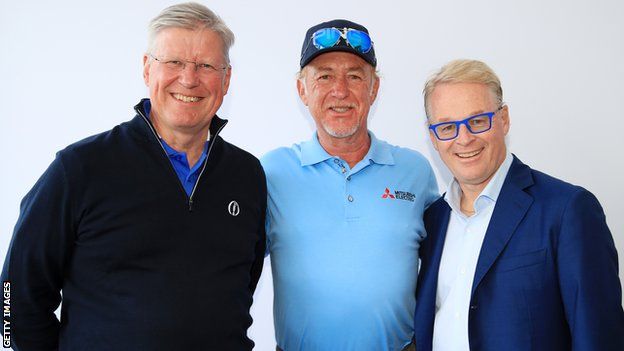Distance debate in golf: R&A and USGA say long hitting should be curbed
- Published
- comments

The R&A's Martin Slumbers (left) now needs key stakeholders such as the European Tour's Keith Pelley (right) to buy into the project
These are turbulent times for golf and the waters could potentially become even more choppy as the game's governing bodies reveal measures are needed to limit the length balls travel off the tee.
After signalling intent to put brakes on the distance players can smash their drives, the R&A and United States Golf Association (USGA), who set the sport's rules, now need more of the game's key stakeholders to buy into the project.
With club and ball manufacturers, as well as leading professional tours, having expressed long-standing reluctance to embrace such moves, rules-makers can expect significant challenges in order to win them over.
This comes at a time when organisations such as the PGA and European Tours are flexing their muscles to fight off the proposed Premier Golf League, with talk of a £183m prize fund in order to lure 48 of the world's best players.
There are currently battlegrounds throughout the sport as it seeks to identify the best way forward. But the main preoccupation of the R&A and USGA is halting the ongoing growth in driving distances.
"This will only be achieved if the whole industry comes together to make sure the game is thriving 50 years from now," R&A chief executive Martin Slumbers told BBC Sport.
There can be no doubting the two years' worth of diligence with which the governing bodies have approached an issue that has implications for golf at every level.
Today's publication of the Distance Insights Project Report, external suggests potentially significant changes are under consideration.
They may lead to alterations to club and ball specifications in order to limit their future effectiveness as well as local rules potentially being introduced for certain courses and competitions.
For years distance has been one of golf's most controversial topics. Many argue the character of the game has been destroyed by saucepan-headed drivers propelling hi-tech modern balls vast distances.
Rory McIlroy believes the mooted new Premier Golf League "could be the catalyst for change" in the game
The report states that in 1995 the top-20 longest hitters in elite male competition averaged 278 yards off the tee. By last year, that figure had risen to 310 yards.
Erin Hills, the Wisconsin course that staged the 2017 US Open, measured a mammoth 7,741 yards yet it did not stop Brooks Koepka's winning score being 16 under par.
"Longer distances, longer courses, playing from longer tees and longer times to play are taking golf in the wrong direction," the report concludes.
"Golf will best thrive over the next decades and beyond if this continuing cycle of ever-increasing hitting distances and golf course lengths is brought to an end."
Longer courses mean higher maintenance costs, greater environmental impact and rounds taking more time to complete.
The report admits a need for "potential changes to the equipment rules" and to "consider whether any existing specifications should be adjusted or any new specifications should be created to help mitigate the continuing distance increases".
All of which will alert manufacturers - whose sales point is the distance gains their clubs and balls can offer the amateur golfer - and the tours, who view massive drives as part of their spectacle.
The R&A and USGA say these bodies are now on notice that change is needed. But nothing will happen imminently, with further input to be sought over much of the next year before anything is decided.
This will be a crucial period as golf seeks a united front on the issue, but the clock is ticking.
Many classic courses have already been rendered obsolete for elite golf and the iconic St Andrews Old Course needs certain tees to be located out of bounds in order to make it long enough to host professional events.
Slumbers, though, says the exhaustive process underway is "absolutely not" a case of kicking the can down the road.
"We now need to have a conversation about where we go. The report does not have any solutions whatsoever; from today is when we start the discussion with the industry."
These will be vital talks that go to the heart of the game's future.
"There are a lot of very serious people who run this industry and working together those serious people can handle and find solutions for a difficult problem," Slumbers added.
"We believe we need to find solutions because otherwise the issues of skill and footprint will just continue to grow and I think that would be detrimental to the game of golf.
"As a governing body we have a real responsibility, both historical and modern, to protect the traditions of this game."
So this is a potentially significant development for the golf industry. The report states: "We believe it is never too late to do the right thing for the future of the game."
However there are many interpretations on what "the right thing" might be and debate will rage over coming months. It seems the need for eventual consensus has never been greater.